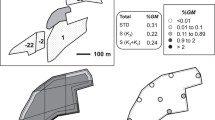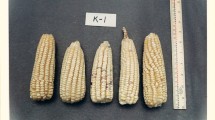Abstract
Regulatory approvals for deliberate release of GM maize events into the environment have lead to real situations of coexistence between GM and non-GM, with some fields being cultivated with GM and conventional varieties in successive seasons. Given the common presence of volunteer plants in maize fields in temperate areas, we investigated the real impact of GM volunteers on the yield of 12 non-GM agricultural fields. Volunteer density varied from residual to around 10% of plants in the field and was largely reduced using certain cultural practices. Plant vigour was low, they rarely had cobs and produced pollen that cross-fertilized neighbour plants only at low—but variable—levels. In the worst-case scenario, the estimated content of GMO was 0.16%. The influence of GM volunteers was not enough to reach the 0.9% adventitious GM threshold but it could potentially contribute to adventitious GM levels, especially at high initial densities (i.e. above 1,000 volunteers/ha).





Similar content being viewed by others
References
Andersen RN, Ford JH, Lueschen WE (1982) Controlling volunteer corn (Zea-Mays) in soybeans (Glycine-Max) with diclofop and glyphosate. Weed Sci 30:132–136
Bannert M (2006) Simulation of transgenic pollen dispersal by use of different grain colour maize. Swiss Federal Institute of Technology, Zurich
Beckett TH, Stoller EW (1988) Volunteer corn (Zea-Mays) interference in soybeans (Glycine-Max). Weed Sci 36:159–166
Bénétrix F, Bloc D (2003) Maïs OGM et non-OGM: possible coexistence. Perspect Agric 294:14–17
Brookes G, Barfoot P, Melé E et al (2004) Genetically modified maize: pollen movement and crop coexistence. PG Economics Ltd
Della Porta G, Ederle D, Bucchini L, Prandi M, Pozzi C, Verderio A (2006) Gene flow between neighboring maize fields in the Po Valley. Centro Documentazione Agrobiotecnologie, Milan
Devos Y, Reheul D, De Schrijver A (2005) The co-existence between transgenic and non-transgenic maize in the European Union: a focus on pollen flow and cross-fertilization. Environ Biosafety Res 4:71–87. doi:10.1051/ebr:2005013
Emberlin J, Adams-Groom B, Tidmarsh J (1999) A report on the dispersal of maize pollen. Soil Association: National Pollen Research Unit, University College Worcester, Worcester
European Commission (2003a) Regulation No 1830/2003 of the European Parliament and of the Council of 22 September 2003 concerning the traceability and labelling of genetically modified organisms and the traceability of food and feed products produced from genetically modified organisms and amending directive 2001/18/EC. Off J Eur Union L 268:24–28
European Commission (2003b) Regulation No 1829/2003 of the European Parliament and of the Council of 22 September 2003 on genetically modified food and feed. Off J Eur Communities L 268:1–23
Henry C, Morgan D, Weekes R et al (2003) Farm scale evaluations of GM crops: monitoring gene flow from GM crops to non GM equivalents in the vicinity: part one forage maize. DEFRA reportEPG/1/5/138
Hernández M, Pla M, Esteve T et al (2003) A specific real-time quantitative PCR detection system for event MON810 in maize YieldGard based on the 3′-transgene integration sequence. Transgenic Res 12:179–189. doi:10.1023/A:1022979624333
Hernández M, Duplan MN, Berthier G et al (2004) Development and comparison of four real-time polymerase chain reaction systems for specific detection and quantification of Zea mays L. J Agric Food Chem 52:4632–4637. doi:10.1021/jf049789d
Husken A, Dietz-Pfeilstetter A (2007) Pollen-mediated intraspecific gene flow from herbicide resistant oilseed rape (Brassica napus L.). Transgenic Res 16:557–569. doi:10.1007/s11248-007-9078-y
Jones M, Brooks J (1950) Effectiveness of distance and border rows in preventing outcrossing in corn. Technical Bulletin T-38. Oklahoma Agricultural Experimental Station, Stillwater
Kiesselbach TA (1999) The structure and reproduction of corn. 50th anniversary edition. Cold Spring Harbor Laboratory Press, New York, pp 88–91
Ma BL, Subedi KD, Reid LM (2004) Extent of cross-fertilization in maize by pollen from neighboring transgenic hybrids. Crop Sci 44:1273–1282
Ministerio de Agricultura, pesca y alimentación (MAPA) (2007) http://www.mapa.es/agricultura/pags/semillas/estadistica
Melé E, Ballester J, Peñas G et al (2004) First results of co-existence study. Euro/Biotech/News 4:8
Messeguer J, Peñas G, Ballester J et al (2006) Pollen-mediated gene flow in maize in real situations of coexistence. Plant Biotechnol J 4:633–645. doi:10.1111/j.1467-7652.2006.00207.x
Meyer R, Jaccaud E (1997) Detection of genetically modified soya in processed food products: development and validation of a PCR assay for the specific detection of Glyphosate-Tolerant Soybeans. 1. Interlaken, Switzerland, pp 23–28
Ortega Molina J (2006) The spanish experience with co-existence after 8 years of cultivation of GM maize. In Proceedings of the co-existence of GM, conventional and organic crops, Freedom of choice Conference. Wien
Pla M, La Paz JL, Peñas G et al (2006) Assessment of real-time PCR based methods for quantification of pollen-mediated gene flow from GM to conventional maize in a field study. Transgenic Res 15:218–228. doi:10.1007/s11248-005-4945-x
Sanvido O, Widmer F, Winzeler M, Streit B, Szerencsits E, Bigler F (2005) An evaluation of measures to ensure agricultural coexistence of GM and non-GM based agricultural supply chains. In: Messéan A (ed) Proceedings of the 2nd international conference on co-existence between GM and non-GM based agricultural supply chains. Agropolis productions, Montpellier, pp 179–182
Treu R, Emberlin J (2000) Pollen dispersal in the crops maize (Zea mays), oilseed rape (Brassica napus ssp. oleifera), potatoes (Solanum tuberosum), sugar beet (Beta vulgaris ssp. vulgaris) and wheat (Triticum aestivum). Soil Association: National Pollen Research Unit. University College Worcester, Worcester
Weber WE, Bringezu T, Broer I et al (2007) Coexistence between GM and non-GM maize crops—tested in 2004 at the field scale level (Erprobungsanbau 2004). J Agron Crop Sci 193:79–92. doi:10.1111/j.1439-037X.2006.00245.x
Acknowledgments
This research was supported by the European Comission (SIGMEA and COEXTRA projects). We are grateful to Sandra Franquesa, Jose Artés and Manoli Cencerrero (IRTA), Albert Roselló and Elena González (Mas Badia) and Ana-Belén Gandía (UdG) for their collaboration in this work.
Author information
Authors and Affiliations
Corresponding author
Additional information
M. Palaudelmàs and G. Peñas contributed equally to this work.
Rights and permissions
About this article
Cite this article
Palaudelmàs, M., Peñas, G., Melé, E. et al. Effect of volunteers on maize gene flow. Transgenic Res 18, 583–594 (2009). https://doi.org/10.1007/s11248-009-9250-7
Received:
Accepted:
Published:
Issue Date:
DOI: https://doi.org/10.1007/s11248-009-9250-7




